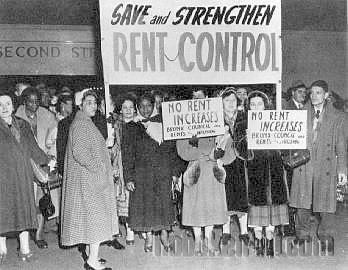
This is one area of economics that really bugs me. For a discipline professing to understand commerce, markets and investment, economics has no widely accepted accepted core theory that allows for systematic economic rents to land owners.
But that doesn’t stop most economists being confident about their opinions on the matter.
Rent control can work. With the right institutional structure we can have any economic outcome we want – it’s just a matter of ensuring rent controls do not conflict with other regulations or incentives.
In the case of rent controls, one key proviso is that alternative non-residential land uses are excluded from certain areas through planning controls. Such provisions remove the potential for commercial uses to outbid for locations and force residential development into less desirable areas.
While this won’t force the development of new dwellings in these areas, it will force land owners seeking greater rents to develop new residential dwellings instead of other buildings.
It might seem odd to talk in terms of ‘forcing’ land owner to develop housing, but we do need to keep in mind that land owners as a group exert monopoly power – they can delay investment indefinitely under most reasonable conditions (for example, if there remains scope for future increases in the intensity of development, and/or if land value can be used as collateral to leverage other investments).
A simple thought experiment can help us get to grips with the dynamics of the rental market. Imagine that all renters could coordinate a nationwide agreement that no one would outbid the current tenant for a home for a period of 10 years.
Immediately each home in the rental market (a seller with a monopoly on its unique location) will face a monopsony buyer (a single potential tenant, since all others have agreed not to bid). The rental bargaining power is evened up to a degree, but is still not that great for the tenant – after all, they can’t choose to rent anywhere else since they have promised not to.
In this situation rents might be bargained down a little.
If most renters had ‘outside alternatives’, for example if they could move in with others should the rental bargain go awry, then they would gain the upper hand. Rents could be bargained down to marginal cost of occupancy (the extra costs incurred in having a tenant rather than leaving the property vacant).
But this is not a satisfactory long run outcome. Rents need to be at least higher than the marginal cost of constructing a new home, even with land costs are zero, if any new housing is going to be built by private land owners. Given the land component of the new housing is usually between 20 and 50% of the cost, this is still a significant scope for rental reductions.
We still face a major problem of competing uses of land, which would be able to bid up land prices. This is why it is necessary to couple rent-controls with zoning controls, to ensure that there are available sites for residential development without competing land uses.
Framing the problem in this way is by no means controversial outside of a particular circle of economic theorists. We know, for example, that economists have “no fully articulated modern model of rent controls”, and that if markets are imperfect, than regulatory controls can be welfare enhancing. Yet even now these models of rents under imperfect competition have had little empirical corroboration, partly due to the lack of consistent rental data collection over long periods of time. Finally, much of the economic analysis focuses on the few cases of residential rent controls in the US, with little attention paid to the long and diverse history of rent controls across Europe.
I would suggest that part of the reason such little attention has been paid to empirically investigating rent controls is the challenge of understanding the complete policy framework in which they operate.
In any case, with this ‘bargaining framework’ in mind, here are some proposals to swing power back to tenants (none of these are original, just variations of what has been implements in different places at different times).
Regulate residential tenancies contracts into short and long term. Short term will be 3 months or less and long term will be any period greater than 3 months. This tiered regulation will allow for short-term holiday-style letting to be treated a particularly flexible way, while stable tenancies are granted much tighter regulatory control. These tighter controls might include these couple of off-the-cuff suggestions
- Include limits on the rate of increase in rent to CPI, as well as limits to the frequency of changes to rents
- Create a national insurance pool for private landlords to cover legal claims on lost rent if certain conditions are met (low income renters etc) – this would allow more flexibility of landlords to accept tenants without track records and even up some of the bargaining power for poor tenants who need it most.
- Default limitations on the ability of tenants to sublease or transfer leases (that can be changed by agreement)
- A government owned corporation that competes in the market for low cost housing in strategic locations (as a builder/developer, not unlike the Brisbane Housing Company).
One we acknowledge that rental prices are a bargaining outcome, between tenants for fixed locations, and between home owners and tenants as a collective, many options for improving undesirable outcomes present themselves. While this thought experiment is by no means the final word, it offers directions to pursue and I hope promotes some experimentation with new policy at least in some locations, which can be later assessed for widespread implementation.
Please share this article. Tips, suggestions, comments and requests to rumplestatskin@gmail.com + follow me on Twitter @rumplestatskin